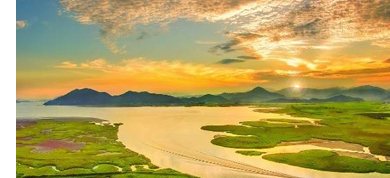| Suncheonman Bay |
Nurtured with the sun, sky and the wind  When it comes to autumn travel, most would be thinking about the beautiful red, orange and yellow canopy of autumn leaves as ideal fall foliage destinations. However, besides that, there is another magnificent sight of autumn – the golden fields of reeds. Suncheonman Bay Wetland Reserve is home to the biggest colony of reeds in Korea, and it is yet another as a perfect way to enjoy autumn by taking leisurely romantic strolls around the park. When it comes to autumn travel, most would be thinking about the beautiful red, orange and yellow canopy of autumn leaves as ideal fall foliage destinations. However, besides that, there is another magnificent sight of autumn – the golden fields of reeds. Suncheonman Bay Wetland Reserve is home to the biggest colony of reeds in Korea, and it is yet another as a perfect way to enjoy autumn by taking leisurely romantic strolls around the park.One of Korea’s main ecological tourist attractions, Suncheon Bay continues to entice a great deal of travelers to its walking trails. During the Suncheon Bay Reed Festival, which wrapped up on October 24, approximately 380,000 visitors flocked to its ecological park surrounded by a mudflat and thickly growing reeds, despite rainfall which struck the bay during two days out of its five-day run. Visitors to Suncheon Bay Ecological Park may witness the unique charm of the place in each of Korea’s distinctive four seasons. However, not many will disagree that the autumn season brings the most splendid vistas that you won’t find in any other season. Watching the glow of the setting sun is a particularly breathtaking experience as it offers a panoramic view of the sun sinking below the horizon through gently-blowing golden reeds. |
 Situated in South Jeolla Province facing the South Sea between the Yeosu and Goheung peninsulas, Suncheon Bay is considered one of the world’s five major coastal wetlands. It is home to Korea’s widest reed bed and a habitat for diverse species of swamp plants as well as some of the rarest winter migration birds, such as the hooded crane. Thus, Suncheon Bay was added to the Ramsar List of Wetlands of International Importance in January 2006. Other tourist attractions located adjacent include the Naganeupseong Folk Village (http://www.suncheon.go.kr/nagan/) alongside centuries-old Songgwang Temple (http://www.songgwangsa.org/) and Seonam Temple. |
 |
 |
| Home > INFORMATION > About Korea |
| About Korea |




